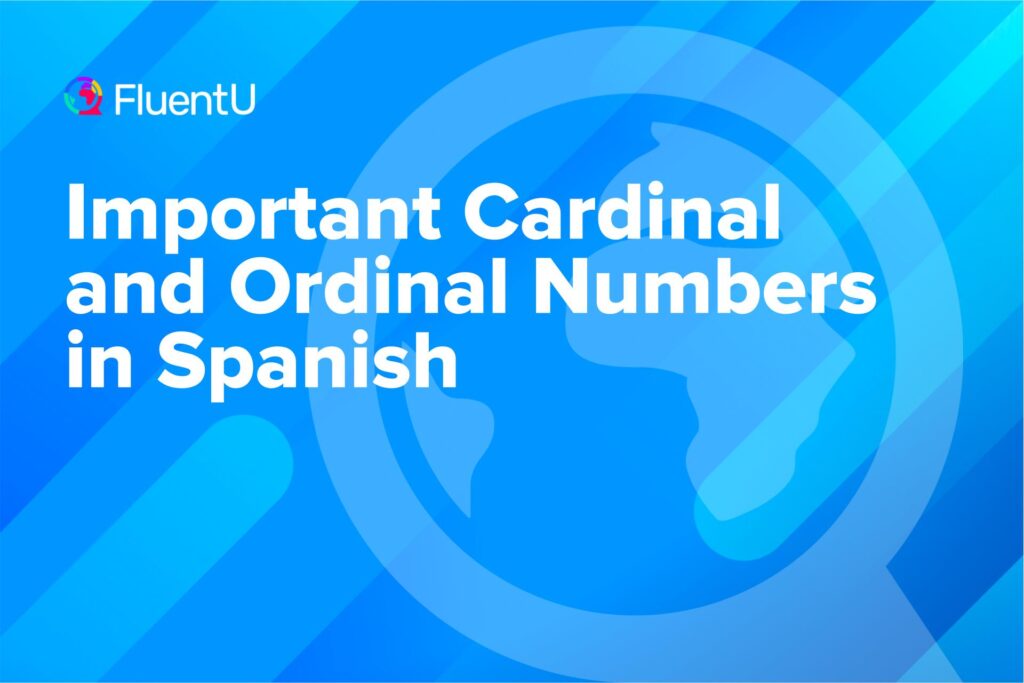Important Cardinal and Ordinal Numbers in Spanish

How many times have you read a text out loud in Spanish only to find a scary number…and proceed to read it in your native language, as if it didn’t exist?
That’s why we’ve created this guide to counting in Spanish with the help of cardinal numbers. Here are our best tips for mastering cardinal numbers in Spanish.
Download: This blog post is available as a convenient and portable PDF that you can take anywhere. Click here to get a copy. (Download)
When to Use Cardinal Numbers in Spanish
“Cardinal numbers” is just a fancy name for the regular numbers we know and use, such as uno, dos and tres (one, two, and three). We use cardinal numbers in Spanish to:
- tell the time when somebody asks “¿Qué hora es?” (“What time is it?”)
- count
- talk about measurements, amounts, prices, ages and weights
- discuss dates, years and centuries
Considering the various ways in which we use numbers in Spanish, you can see why it’s pretty much impossible to avoid numbers when learning the language. Not only should they be mandatory in your personal study plan, you should also go back once in a while and review them.
Numbers 1-20 in Spanish
The first number in Spanish deserves its own explanation since it’s special: it has one feminine and two masculine versions! Remember to use un for a singular masculine noun (un coche — “a car”) and una for a singular feminine noun (una razón — a reason).
Uno is only used when actually counting, so it’s less common.
2 — dos
3 — tres
4 — cuatro
5 — cinco
6 — seis
7 — siete
8 — ocho
9 — nueve
10 — diez
The numbers from 11 to 20 are quite irregular:
11 — once
12 — doce
13 — trece
14 — catorce
15 — quince
16 — dieciséis
17 — diecisiete
18 — dieciocho
19 — diecinueve
20 — veinte
Examples
Tengo dos hijos. (I have two children.)
Es catorce de noviembre. (It’s the 14th of November.)
Si aún no tienes dieciocho años, no puedes comprar alcohol en España. (If you aren’t 18 years old yet, you cannot buy alcohol in Spain.)
Es un teléfono muy barato. ¡Sólo cuesta cinco euros! (It’s a very cheap phone. It only costs five euros!)
Into the 20s
The formula for counting from 20 to 30 is similar to what you might have noticed about numbers 16, 17, 18 and 19. To count beyond 20, you use a shortened version of veinte + y + number. Check it out in action:
21 — veintiuno
22 — veintidós
23 — veintitrés
24 — veinticuatro
25 — veinticinco
26 — veintiséis
27 — veintisiete
28 — veintiocho
29 — veintinueve
Examples
Él no para de hablar de sus aventuras de cuando tenía veintiocho años. (He won’t stop talking about his adventures from when he was 28 years old.)
Tengo veintidós (22) dólares, pero la falda cuesta veintitrés dólares. (I have 22 dollars, but the skirt costs 23 dollars.)
Viajé a Argentina el veintiséis de abril. (I traveled to Argentina on the 26th April.)
Todos tienen veinticuatro horas en su día, pero algunos las usan mejor que otros. (All people have 24 hours in their day, but some use them better than others.)
30s, 40s and Beyond
The logic that applied to the 20s also applies to the 30s, 40s, 50s and beyond until 100. The first and most important step is knowing the following numbers by heart:
30 — treinta
40 — cuarenta
50 — cincuenta
60 — sesenta
70 — setenta
80 — ochenta
90 — noventa
Once you get comfortable with these numbers, you’re free to apply the following logic: main number + y + secondary number. For instance:
41 — cuarenta y uno
73 — setenta y tres
32 — treinta y dos
54 — cincuenta y cuatro
82 — ochenta y dos
99 — noventa y nueve
Examples
Tengo noventa y nueve problemas, pero el dinero no es uno. (I’ve got 99 problems, but money isn’t one.)
Mi abuela tiene ochenta y cinco años: ya no puede correr rápido. (My grandma is 85 years old—she can’t run fast anymore.)
Mido un metro ochenta. (I am 1.80 meters in height.)
¡No tenemos tiempo! El autobús sale en treinta minutos. (We don’t have time! The bus departs in 30 minutes.)
Exploring the 100s in Spanish
On its own, the number 100 is cien. However, when you want to associate this number with others, you do not use y. Instead, you use ciento:
102 — ciento dos
130 — ciento treinta
150 — ciento cincuenta
The happens with all the hundreds. Here they are up to 900:
200 — doscientos
300 — trescientos
400 — cuatrocientos
500 — quinientos
600 — seiscientos
700 — setecientos
800 — ochocientos
900 — novecientos
To name any three-digit number, simply note the number in the hundreds digit then add the rest of the number after it as you learned earlier in this post:
201 — doscientos uno
354 — trescientos cincuenta y cuatro
402 — cuatrocientos dos
560 — quinientos sesenta
806 — ochocientos seis
910 — novecientos diez
Examples
Hay ciento noventa y cinco países en el mundo. (There are 195 countries in the world.)
Aquí están las llaves de la habitación doscientos cuatro. (Here are the keys for room 204.)
Mi película favorita en español es “Celda doscientos once”. (My favorite movie in Spanish is “Cell 211.”)
Un año tiene trescientos sesenta y cinco días. (A year has 365 days.)
1,000 and Over
Numbers over 1000 are actually pretty easy to remember in Spanish. Just use the regular numbers from one to 10 and add the word “mil”!
1,000 — mil
2,000 — dos mil
3,000 — tres mil
4,000 — cuatro mil
5,000 — cinco mil
6,000 — seis mil
7,000 — siete mil
8,000 — ocho mil
9,000 — nueve mil
10,000 — diez mil
Examples
Estamos en el dos mil veintitrés. (We’re in 2023.)
Se cree que hay siete mil noventa y siete lenguas en el mundo. (It’s believed that there are 7,097 languages in the world.)
Si tuviera diez mil dólares, renunciaría a mi trabajo mañana. (If I had 10,000 dollars, I’d quit my job tomorrow.)
Un cocodrilo puede pesar hasta mil cuarenta y tres kilogramos. (A crocodile can weigh up to 1,043 kg.)
Spanish Ordinal Numbers
Ordinal numbers are used to indicate the position of something, or the order in which something appears. These numbers need to be modified to match both the gender and the number of the noun they are referring to. The Spanish ordinal numbers 1-9 are as follows:
Primero
— first
Segundo
— second
Tercero
— third
Cuarto
— fourth
Quinto
— fifth
Sexto
— sixth
Séptimo
— seventh
Octavo
— eighth
Noveno
— ninth
You can say the numbers in the tens like this:
Décimo
— tenth
Vigésimo
— twentieth
Trigésimo
— thirtieth
Cuadragésimo
— fortieth
Quincuagésimo
— fiftieth
Sexagésimo
— sixtieth
Septuagésimo
— seventieth
Octogésimo
— eightieth
Nonagésimo
— ninetieth
Centésimo
— hundredth
For any number in between, you just take the relevant tens number, and add an ordinal number from 1-9. Here are some examples:
Trigésimo tercero
— thirty-third
Cuadragésimo noveno
— forty-ninth
Sexagésimo séptimo
— sixty-seventh
Octogésimo quinto
— eighty-fifth
Nonagésimo sexto
— ninety-sixth
Examples
Él llegó a la meta en quinto lugar. (He came in fifth place at the finish line..)
Mañana es el vigésimo aniversario de mis padres. (Tomorrow is my parents’ 20th anniversary.)
Él es el sexagésimo segundo presidente de mi país. (He is the 62nd president of my country.)
Esta canción cayó de la novena posición a la decimocuarta. (This song fell from 9th position to 14th.)
For extra practice, here’s a fun story-based lesson on ordinal numbers from our YouTube channel:
Strategies to Learn Numbers in Spanish
Here are some study tips to help you learn numbers in Spanish and actually use them, rather than avoiding them like the plague.
Choose Relevance, not Cramming
There’s a better way than just memorizing lists! It’s way smarter to start by answering these questions:
- How old are you?
- What’s your year of birth?
- What’s the current year?
- What’s your height/weight?
- What’s your ID/passport number?
- What day is it today? Tomorrow? Yesterday?
When learning Spanish, it’s crucial that you avoid overwhelming yourself by focusing on numbers and information that are relevant to you, first!
Use Flashcards
Flashcards are a learner’s best friend whether you’re a fan of paper or digital tools. You have two options here:
1. Direct translations: On one side of the flashcard, write the number in English. On the other side, write the number in Spanish. Study these flashcards regularly until you know the numbers by heart.
2. Images rather than translations: On one side of the flashcard, place an image that represents a given number. On the other side of the card, write that number in Spanish. You now have visual cues rather than words in English.

There are several apps that let you create and customize flashcards to your liking, making them more memorable. AnkiApp is a great example of this, but there are many other options, like Cram.com and Flashcard Machine.
Use Spaced Repetition
Spaced repetition is effective because it invites you to hack your brain by understanding its flaws and using them to your advantage to memorize Spanish vocabulary.
Start by studying your Spanish numbers. Try to memorize the most relevant ones. Now, allow your brain to almost forget them.
When you feel that you cannot remember one or two numbers by heart anymore, it’s time to strike again. You’ll be defining spaced intervals to revisit your cards, preferably separating those you already know effortlessly from the ones you keep struggling with.
To aid with this method, you can try using a language learning platform like FluentU.
FluentU takes authentic videos—like music videos, movie trailers, news and inspiring talks—and turns them into personalized language learning lessons.
You can try FluentU for free for 2 weeks. Check out the website or download the iOS app or Android app.
P.S. Click here to take advantage of our current sale! (Expires at the end of this month)

If you’re interested in the concept, you can learn more about spaced repetition and how it can serve you in this video:
Produce, Produce, Produce
Purely listening and watching isn’t the way to become fluent.
For that reason, you should produce. That means speaking and writing with Spanish numbers! How? Well, see those example sentences we included throughout the blog post? We suggest the following practice:
1. Select sentences from the examples that seem useful to you and that you’d actually use.
2. Copy those sentences word by word on a sheet of paper. Then, read them aloud.
3. Let a few days go by, then return to your practice. Now, try changing the numbers in the sentences and, once again, read them out loud.
4. You should now create sentences that are about your own personal history, referring to important events or accomplishments.
5. Repeat those sentences both in writing and speaking, as if you were talking to somebody.
Follow these steps to counting success!
Don’t forget that you’re learning Spanish for your own development, your own communication abilities and for your own use. That means you shouldn’t be afraid to select, customize and study what’s appropriate for you, even with something as seemingly simple as numbers in Spanish.
In other words… make it about yourself.
And don’t forget to have fun!
Download: This blog post is available as a convenient and portable PDF that you can take anywhere. Click here to get a copy. (Download)
And One More Thing…
If you've made it this far that means you probably enjoy learning Spanish with engaging material and will then love FluentU.
Other sites use scripted content. FluentU uses a natural approach that helps you ease into the Spanish language and culture over time. You’ll learn Spanish as it’s actually spoken by real people.
FluentU has a wide variety of videos, as you can see here:

FluentU brings native videos within reach with interactive transcripts. You can tap on any word to look it up instantly. Every definition has examples that have been written to help you understand how the word is used. If you see an interesting word you don’t know, you can add it to a vocab list.

Review a complete interactive transcript under the Dialogue tab, and find words and phrases listed under Vocab.

Learn all the vocabulary in any video with FluentU’s robust learning engine. Swipe left or right to see more examples of the word you’re on.

The best part is that FluentU keeps track of the vocabulary that you’re learning, and gives you extra practice with difficult words. It'll even remind you when it’s time to review what you’ve learned. Every learner has a truly personalized experience, even if they’re learning with the same video.
Start using the FluentU website on your computer or tablet or, better yet, download the FluentU app from the iTunes or Google Play store. Click here to take advantage of our current sale! (Expires at the end of this month.)







